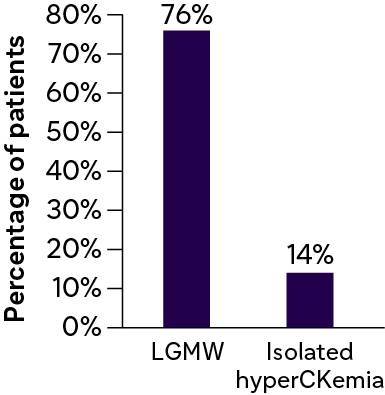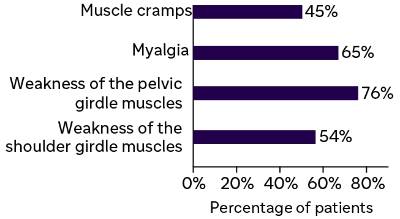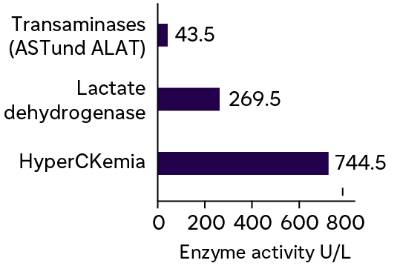Prevalence Of LOPD In Patients With Undifferentiated Proximal Myopathy And Undiagnosed Muscle Biopsy
Study objective and method
 Examine patients with
Examine patients with
LGMW and/or
hyperCKemia and
undiagnosed muscle
biopsy for LOPD
 Inclusion criteria:
Inclusion criteria:
Inconclusive LGMW with
undiagnosed muscle
biopsies
 Of the 340
Of the 340
evaluated muscle
biopsies,
69 fulfilled the
inclusion criteria
Testing:
DBS+enzyme
activity of GAA
Results
Baseline characteristics of patients with unclassified LGMW
%20(1).jpg)
Median age
51 years
Median symptom onset
6 years
Clinical and laboratory data of patients with unclassified LGMW
Median DBS GAA
activity: 1.18
nmol/punch×21 hours
Reduced GAA activity
was identified through
enzyme kinetic testing
in two patients
Myopathic symptoms
.jpg)
Laboratory results
.jpg)
Diagnostic yield of LOPD: 2/69 (2.9%)
| Patient 1 |  |
Patient 2 |
| A 22-year–old Caucasian female with the chief complaint of muscular exertion intolerance associated with muscle aches and cramps. |
Patient profile
|
A 29-year–old Caucasian male with atrophies of the shoulder, pelvic girdle, and paravertebral muscles. Predominantly left-sided scapula alata and positive Gower’s sign. |
| Completely unspecific myopathic changes with evidence of small lipid droplets |
Muscle biopsy
|
|
No signs of HCM, FVC: <80% |
Other findings |
No signs of HCM, FVC: 72% |
LOPD not only demonstrates wide variability in the clinical phenotype but also in the histopathological changes in the skeletal muscles.
Conclusion

Revisiting muscle biopsies is important in neuromuscular disease diagnosis.

Muscle biopsy can aid in LOPD identification, but glycogen-related vacuolation can be absent.

An inconclusive muscle biopsy does not rule out Pompe disease.

DBS evaluation should precede muscle biopsy for all LGMW patients
ALAT: Alanine aminotransferase; AST: Aspartate transaminase; CK: Creatine kinase; DBS: Dried blood spots; FVC: Forced vital capacity; HCM: Hypertrophic cardiomyopathy; LGMW: Limb-girdle myopathic weakness; LOPD: Late-onset Pompe disease.
- Golsari A, Nasimzadah A, Thomalla G, et al. Prevalence of adult Pompe disease in patients with proximal myopathic syndrome and undiagnosed muscle biopsy. Neuromuscul Disord. 2018;28(3):257–261.

.jpg/jcr:content/jcr_content%20(26).jpg)
.png)



.jpg/jcr:content/jcr_content%20(39).jpg)
.jpg/jcr:content/jcr_content%20(37).jpg)